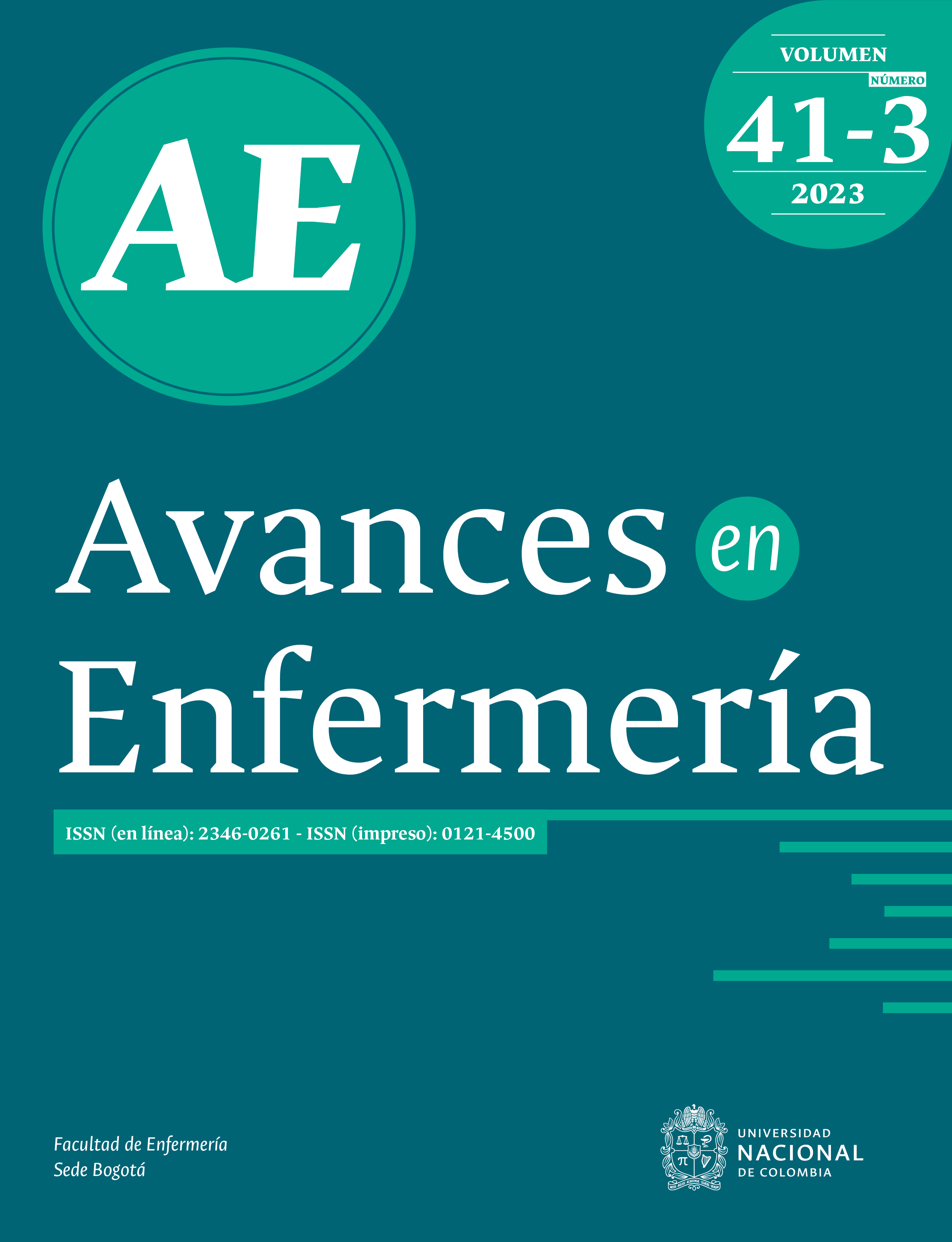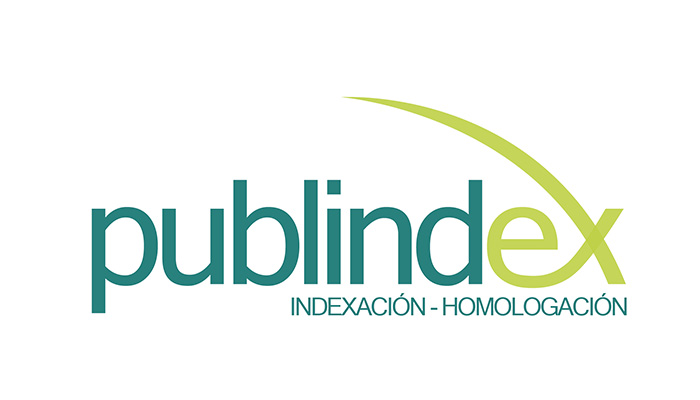NANDA taxonomy and insomnia evaluation scale in older people: A crosssectional study
Taxonomía NANDA y escala de evaluación del insomnio en personas mayores: un estudio transversal
Taxonomia NANDA e escala de avaliação da insônia em idosos: um estudo transversal
DOI:
https://doi.org/10.15446/av.enferm.v41n3.111620Keywords:
Senior Centers, Geriatric Assessment, Sleep Wake Disorders, Cross-Sectional Studies, Sleep Quality (en)Centros para Personas Mayores, Evaluación Geriátrica, Trastornos del Sueño-Vigilia , Estudios Transversales, Calidad del Sueño (es)
Centros Comunitários para Idosos, Avaliação Geriátrica, Transtornos do Sono-Vigília, Estudos Transversais, Qualidade do Sono (pt)
Downloads
Objective: To identify the prevalence of indicators of the nursing diagnosis “insomnia” in older people through the Insomnia Severity Index (ISI) scale.
Materials and methods: Cross-sectional epidemiological study involving older individuals from a community center. Data analysis was conducted between July and August 2021 using the R program. Univariate analysis was adopted for sociodemographic characterization. The χ² test (Pearson’s chi-square) was employed to assess the association between the sociodemographic variables, nursing diagnosis indicators, and the ISI.
Results: A total of 90 older people (mean age = 76.8 years, SD = 7.2 years) with at least one defining characteristic were included in this study. There was a higher prevalence of the diagnostic indicators “insufficient physical endurance” (75.6%; 95% CI: 65-83%) and “average daily physical activity is less than recommended for age and gender” (71.1%; 95% CI: 61-79%). In contrast, the diagnostic indicators “increased accidents” (6.7%; 95% CI: 3-13%) and “lifestyle incongruent with normal circadian rhythms” (2.2%; 95% CI: 92-99%) had a lower prevalence. A significant association was found between ISI, the defining characteristics (p = 0.009; < 0.001; 0.005; 0.002; 0.022; < 0.001; 0.004; < 0.001), and the related factors (p = 0.007; 0.004; < 0.001; 0.006; 0.049) of nursing diagnosis.
Conclusions: The prevailing indicators of insomnia in community-dwelling older individuals were demonstrated in our sample and their association with a validated clinical assessment survey was established. These findings may contribute to nurses’ diagnostic accuracy and their ability to conduct effective diagnostic screening in older populations.
Objetivo: identificar la prevalencia de los indicadores del diagnóstico de enfermería “insomnio” en ancianos mediante el índice de severidad del insomnio (ISI).
Materiales y método: estudio epidemiológico transversal con ancianos de un centro comunitario. El análisis de los datos se realizó entre julio y agosto de 2021 utilizando el programa R. Se empleó el análisis univariado para la caracterización sociodemográfica. Se utilizó la prueba χ² (chi cuadrado de Pearson) para evaluar la asociación entre las variables sociodemográficas, los indicadores de diagnóstico de enfermería y el ISI.
Resultados: 90 ancianos (media = 76,8 años, DT = 7,2 años) con al menos una característica definitoria fueron incluidos en esta investigación. Se observó una mayor prevalencia de los indicadores de diagnóstico “resistencia física insuficiente” (75,6 %; IC 95 %: 65-83 %) y “actividad física diaria promedio inferior a la recomendada para la edad y el sexo” (71,1 %; IC 95 %: 61-79 %). Los indicadores diagnósticos “aumento de accidentes” (6,7 %; IC 95 %: 3-13 %) y “estilo de vida incoherente con ritmos circadianos normales” (2,2 %; IC 95 %: 92 % - 99 %) reportaron una prevalencia más baja. Se encontró una asociación significativa entre los ISI, las características definitorias (p = 0,009; < 0,001; 0,005; 0,002; 0,022; < 0,001; 0,004; < 0,001) y los factores relacionados (p = 0,007; 0,004; < 0,001; 0,006; 0,049) del diagnóstico de enfermería.
Conclusiones: los indicadores prevalentes de insomnio en ancianos que viven en comunidades fueron evidenciados en nuestra muestra, estableciendo además su asociación con una encuesta de evaluación clínica validada. Estos resultados pueden contribuir a una mayor precisión en los diagnósticos de enfermería y a fortalecer la capacidad de realizar un cribado diagnóstico asertivo en la población anciana.
Objetivo: identificar a prevalência dos indicadores do diagnóstico de enfermagem “insônia” em idosos por meio do índice de gravidade da insônia (IGI).
Materiais e método: estudo epidemiológico do tipo transversal com idosos frequentadores de um centro de convivência. A análise dos dados foi realizada entre julho e agosto de 2021 no programa R. Para a caracterização sociodemográfica, foi adotada a análise univariada. Foi aplicado o teste χ² (qui-quadrado de Pearson) para avaliar a associação entre as variáveis sociodemográficas, os índices do diagnóstico de enfermagem e o IGI.
Resultado: 90 participantes foram incluídos (média = 76,8 anos, DP = 7,2 anos) e apresentaram ao menos uma característica definidora. Houve maior prevalência dos índices diagnósticos “resistência física insuficiente” (75,6%; IC 95%: 65-83%) e “média de atividade física diária inferior à recomendada para idade e sexo” (71,1%; IC 95%: 61-79%). Em contrapartida, os índices diagnósticos “Aumento de acidentes” (6,7%; IC 95%: 3-13%) e “Estilo de vida incoerente com ritmos circadianos normais” (2,2%; IC 95%: 92-99%) obtiveram menor prevalência. Houve associação significativa entre a IGI, as características definidoras (p = 0,009; < 0,001; 0,005; 0,002; 0,022; < 0,001; 0,004; < 0,001) e os fatores relacionados (p = 0,007; 0,004; < 0,001; 0,006; 0,049) do diagnóstico de enfermagem.
Conclusões: foram evidenciados os indicadores prevalentes de insônia em idosos não institucionalizados em nossa amostra, e sua associação foi feita com instrumento de avaliação clínica validado. Tais resultados poderão contribuir para maior acurácia nos diagnósticos de enfermagem e fortalecer a capacidade de triagem diagnóstica assertiva na população idosa.
References
(1) Casagrande M; Forte G; Favieri F; Corbo I. Sleep quality and aging: A systematic review on healthy older people, mild cognitive impairment and Alzheimer’s disease. IJERPH . 2022;19(14):8457. http://doi.org/10.3390/ijerph19148457
(2) Gorgoni M; De Gennaro L. Sleep in the aging brain. Brain Sci. 2021;11(2):229. http://doi.org/10.3390/brainsci11020229
(3) Mendonça FMR; Mendonça GPRR; Souza LC; Galvão LP; Paiva HS; Périco CAM et al. Benzodiazepines and sleep architecture: A systematic review. CNS Neurol Disord Drug Targets. 2023;22(2):172-179. http://doi.org/10.2174/1871527320666210618103344
(4) Thangaleela S; Sivamaruthi BS; Kesika P; Mariappan S; Rashmi S; Choeisoongnern T et al. Neurological insights into sleep disorders in Parkinson’s disease. Brain Sci. 2023;13(8):1202. http://doi.org/10.3390/brainsci13081202
(5) Brewster GS; Riegel B; Gehrman PR. Insomnia in the older adult. Sleep Med Clin. 2022;17(2):233-239. http://doi.org/10.1016/j.jsmc.2022.03.004
(6) Ganidagli S; Ozturk E; Ozturk ZA. Risk factors of poor sleep quality in older adults: An analysis based on comprehensive geriatric assessment. Curr Med Res Opin. 2023;39(5):701-706. http://doi.org/10.1080/03007995.2023.2192124
(7) Pazan F; Wehling M. Polypharmacy in older adults: A narrative review of definitions, epidemiology and consequences. Eur Geriatr Med. 2021;12:443-452. http://doi.org/10.1007/s41999-021-00479-3
(8) Benca RM; Teodorescu M. Sleep physiology and disorders in aging and dementia. In: Dekosky ST; Asthana S (Eds.). Handbook of Clin Neurol. Vol 167. Elsevier; 2019. p. 477-493. https://doi.org/10.1016/B978-0-12-804766-8.00026-1
(9) Bollu PC; Kaur H. Sleep medicine: Insomnia and sleep. Mo Med. 2019;116(1):68-75. https://www.ncbi.nlm.nih.gov/pmc/articles/PMC6390785/
(10) Riemann D; Krone LB; Wulff K; Nissen C. Sleep, insomnia, and depression. Neuropsychopharmacol. 2020;45:74-89. http://doi.org/10.1038/s41386-019-0411-y
(11) United Nations. Policy Brief: COVID-19 and the Need for Action on Mental Health. United States (USA ); 2020. https://bit.ly/3SVV7K6
(12) Álvarez Muñoz FJ; Rubio-Aparicio M; Gurillo Muñoz P; García Herrero AM; Sánchez-Meca J; Navarro-Mateu F. Suicide and dementia: Systematic review and meta-analysis. Rev Psiquiatr Salud Ment. 2020;13(4):213-227. http://doi.org/10.1016/j.rpsm.2020.04.012
(13) Steiner ABQ; Jacinto AF; Citero VA. Older adults with dementia: Knowledge and attitudes of physicians in health units. Rev Saúde Pública. 2020;(54):137. https://doi.org/10.11606/s1518-8787.2020054002451
(14) Borges CR; Poyares D; Piovezan R; Nitrini R; Brucki S. Alzheimer’s disease and sleep disturbances: A review. Arq Neuro-Psiquiatr. 2019;77(11):815-824. https://doi.org/10.1590/0004-282X20190149
(15) Herdman TH; Kamitsuru S; Lopes CT. NANDA International, Inc. Nursing diagnoses: Definitions and classification, 2020-2023. 12th ed. New York: Thieme; 2021.
(16) Alnawwar MA; Alraddadi MI; Algethmi RA; Salem GA; Salem MA; Alharbi AA. The effect of physical activity on sleep quality and sleep disorder: A systematic review. Cureus. 2023;15(8):e43595. https://doi.org/10.7759/cureus.43595
(17) Cardoso RB; Souza PA; Caldas CP; Bitencourt GR. Diagnósticos de enfermagem em idosos hospitalizados à luz da teoria do conforto de Kolcaba. Rev. Enferm. Ref. 2020;5(4):e20066. http://doi.org/10.12707/RV20066
(18) Nogueira ILA; Tinôco JDS; Fernandes MICD; Delgado MF; Lisboa IND; Lopes MVO et al. The diagnostic accuracy of delayed development in adolescents. Int J Nurs Knowl. 2021;32(3):150-156. https://doi.org/10.1111/2047-3095.12304
(19) Eckerblad J; Klompstra L; Heinola L; Rojlén S; Waldréus N. What frail, older patients talk about when they talk about self-care-a qualitative study in heart failure care. BMC geriatrics, 2023;23:818. https://doi.org/10.1186/s12877-023-04538-1
(20) Madeira E; Machado JR; Alfradique P; Macedo EC; Carvalho CM; Koike RY. Quality of life in elderly residents of a community center. R Pesq Cuid Fundam. 2022;14:e-11865. https://doi.org/10.9789/2175-5361.rpcfo.v14.11865
(21) Instituto Brasileiro de Geografia e Estatística (IBGE). Censo Brasileiro de 2022. Rio de Janeiro: IBGE; 2023. https://www.ibge.gov.br/
(22) Loureiro CV; de Oliveira CR; Silva EJGS; de Oliveira GL; da Paz MT; de Oliveira MCS et al. Brasil chegou a vez das Anas, Terezas e Dalvas: Reflexões sobre racismo junto às idosas do Programa Renascer – HUGG. Ra. e Rum. 2021;9(1):94-105. https://doi.org/10.9789/2317-7705.2021.v9.i1.94-105
(23) Pashmdarfard M; Azad A. Assessment tools to evaluate Activities of Daily Living (ADL) and Instrumental Activities of Daily Living (IADL) in older adults: A systematic review. Med J Islam Repub Iran. 2020;34:33. https://pubmed.ncbi.nlm.nih.gov/32617272/
(24) Moghadas T; Kesbakhi MS. Factors influencing implementation of nursing process by nursing students: A qualitative study. J Med Edu. 2020;19(4):e110810. https://doi.org/10.5812/jme.110810
(25) Wells SY; Dietch JR; Edner BJ; Glassman LH; Thorp SR; Morland LA et al. The development of a brief version of the Insomnia Severity Index (ISI-3) in older adult veterans with posttraumatic stress disorder. Behav Sleep Med. 2021;19(3):352-362. https://doi.org/10.1080/15402002.2020.1760278
(26) Castro LS. Adaptação e validação do Índice de Gravidade de Insônia (IGI): Caracterização populacional, valores normativos e aspectos associados. São Paulo: Universidade Federal de São Paulo; 2011. https://repositorio.unifesp.br/handle/11600/23193
(27) Jodrá P; Jiménez-Gamero MD. A quantile regression model for bounded responses based on the exponential-geometric distribution. Revstat. 2020;18(4):415-436. https://doi.org/10.57805/revstat.v18i4.309
(28) República Federativa do Brasil. Ministério da Saúde. Conselho Nacional de Saúde. Resolução n.° 466 de 12 de dezembro de 2012. https://www.gov.br/conselho-nacional-de-saude/pt-br/acesso-ainformacao/legislacao/resolucoes/2012/resolucao-no-466.pdf/view
(29) República Federativa do Brasil. Ministério da Saúde. Conselho Nacional de Saúde. Resolução n° 510 de 07 de abril de 2016. https://www.gov.br/conselho-nacional-de-saude/pt-br/acesso-ainformacao/legislacao/resolucoes/2016/resolucao-no-510.pdf/view
(30) Alves AN; Coura AS; França ISX; Magalhães IMO; Rocha MA; Araújo RS. Acesso de primeiro contato na atenção primária: uma avaliação pela população masculina. Rev. bras. epidemiol. 2020;23:e200072. https://doi.org/10.1590/1980-549720200072
(31) Ramos CV; Fronteira I; Silva ZM; Holanda AMC; Paz SMRS; Pereira TG et al. Tendência temporal e diferenças regionais na mortalidade materna no estado do Piauí, 2006-2021. Cad. Estud. Soc. 2022;37(1):1-19. https://doi.org/10.33148/CESv37n1(2022)2106
(32) República Federativa do Brasil. Ministério da Economia, Secretaria Especial de Previdência e Trabalho. Previdência complementar para mulheres: Guia para mulheres que querem cuidar do seu futuro. Brasília: Ministério da Economia; 2021. https://bit.ly/49wq5xR
(33) Lee SB; Oh JH; Park JH; Choi SP; Wee JH. Differences in youngest-old, middle-old, and oldest-old patients who visit the emergency department. Clin Exp Emerg Med. 2018;5(4):249-255. https://doi.org/10.15441/ceem.17.261
(34) Chung E; Lee SH; Lee HJ; Kim YH. Comparative study of young-old and old-old people using functional evaluation, gait characteristics, and cardiopulmonary metabolic energy consumption. BMC Geriatr. 2023;23:400. https://doi.org/10.1186/s12877-023-04088-6
(35) Tavares DMS; Oliveira NGN; Santos LLS; Marchiori GF; Souza LA; Rodrigues FR. Condições de saúde de mulheres e homens idosos com idade avançada: estudo longitudinal. Rev. enferm. UERJ. 2021;29(1):e57581. http://doi.org/10.12957/reuerj.2021.57581
(36) Organisation for Economic Co-operation and Development (OECD). Fertility rates. Paris: OECD; 2023. https://data.oecd.org/pop/fertility-rates.htm
(37) Higgins SSS; Hinojosa Luna AP; Santos RO; Rabelo AMP; Soalheiro M; Ferreira VC. Um estudo sobre as taxas de contatos sociais relevantes para a difusão de doenças infecciosas em um aglomerado brasileiro. Rev. bras. estud. popul. 2023;40:e0241. https://doi.org/10.20947/S0102-3098a0241
(38) Fundação Perseu Abramo (FPA). Idosos no Brasil II-vivências, desafios e expectativas na terceira idade. Publicações Perseu Abramo. Brasil; 2020. https://bit.ly/49xahLg
(39) Romero DE; Muzy J; Damacena GN; Souza NA; Almeida WS; Szwarcwald CL et al. Older adults in the context of the COVID-19 pandemic in Brazil: Effects on health, income and work. Cad. Saúde Pública, 2021;37(3):e00216620. https://doi.org/10.1590/0102-311X00216620
(40) Cruz AG; Lopes MCFG; Reis LFPC dos; Parola VSO. Prevalência e caracterização de acidentes domésticos e lazer de idosos em contexto comunitário: Estudo observacional transversal. Rev. Enf. Ref. 2022;6(1):e21119. https://doi.org/10.12707/RV21119
(41) Guandalini LS; da Silva EF; Lopes JL; Santos VB; Lopes CT; de Barros ALBL. Analysis of the evidence of related factors, associated conditions and at-risk populations of the NANDA-I nursing diagnosis insomnia. Int. J. Nurs. Sci. 2020;7(4):466-476. https://doi.org/10.1016/j.ijnss.2020.09.003
(42) Kim I; Ahn J. The effect of changes in physical self-concept through participation in exercise on changes in self-esteem and mental well-being. Int. J. Environ. Res. Public Health. 2021;18(10):5224. http://doi.org/10.3390/ijerph18105224
(43) Sejbuk M; Mirończuk-Chodakowska I; Witkowska AM. Sleep quality: A narrative review on nutrition, stimulants, and physical activity as important factors. Nutrients. 2022;14(9):1912. https://doi.org/10.3390/nu14091912
(44) Endeshaw YW; Yoo W. Organized social activity, physical exercise, and the risk of insomnia symptoms among community-dwelling older adults. J Aging Health. 2019;31(6):989-1001. https://doi.org/10.1177/0898264317747705
(45) Meyer N; Harvey AG; Lockley SW; Dijk DJ. Circadian rhythms and disorders of the timing of sleep. Lancet. 2022;400(10357):1061-1078. https://doi.org/10.1016/S0140-6736(22)00877-7
(46) Zhang D; Li S. Family members’ abuse of older adults, psychological well-being, and sleep quality among older women and men in China. J appl gerontol. 2024;43(2):205-214. https://doi.org/10.1177/07334648231203835
(47) Wu F; Sheng Y. Social support network, social support, self-efficacy, health-promoting behavior and healthy aging among older adults: A pathway analysis. Arch Gerontol Geriatr. 2019;85:103934. https://doi.org/10.1016/j.archger.2019.103934
(48) Donizzetti AR. Ageism in an aging society: The role of knowledge, anxiety about aging, and stereotypes in young people and adults. Int J Environ Res Public Health. 2019;16(8):1329. https://doi.org/10.3390/ijerph16081329
(49) Wichniak A; Bieńkowski P; Dąbrowski R; Mastalerz-Migas A; Rymaszewska J. Treatment of insomnia in older adults. Recommendations of the Polish Sleep Research Society, Polish Society of Family Medicine and the Polish Psychiatric Association. Psychiatr pol. 2023;57(3):495-516. https://doi.org/10.12740/PP/OnlineFirst/161597
(50) González-Martín AM; Aibar-Almazán A; Rivas-Campo Y; Marín-Gutiérrez A; Castellote-Caballero Y. Effects of mindfulness-based cognitive therapy on older adults with sleep disorders: A systematic review and meta-analysis. Front. public health. 2023;11:1242868. https://doi.org/10.3389/fpubh.2023.1242868
(51) Yuan K; Zheng YB; Wang YJ; Sun YK; Gong YM; Huang YT et al. A systematic review and meta-analysis on prevalence of and risk factors associated with depression, anxiety and insomnia in infectious diseases, including COVID-19: A call to action. Mol Psychiatry. 2022;27:3214-3222. https://doi.org/10.1038/s41380-022-01638-z
(52) Curtis K; Fry M; Shaban RZ; Considine J. Translating research findings to clinical nursing practice. J Clin Nurs. 2017;26(5-6):862-872. http://doi.org/10.1111/jocn.13586
(53) Luckhardt EM; Gunnels MS; Chlan LL. Assessing discomfort in critically ill patients: A narrative review of the literature. Crit Care Nurse. 2022;42(4):47-54. https://doi.org/10.4037/ccn2022280
How to Cite
VANCOUVER
ACM
ACS
APA
ABNT
Chicago
Harvard
IEEE
MLA
Turabian
Download Citation
License
Copyright (c) 2023 Adriana Souza Szpalher, Rosane Barreto Cardoso, Carleara Weiss, Priscilla Alfradique de Souza

This work is licensed under a Creative Commons Attribution-NonCommercial 4.0 International License.
All articles published by Avances en Enfermería are licensed under the Creative Commons Attribution 4.0 International License. Starting 2020, we added the CC-BY-NC recognition to the license, which means anyone is allowed to copy, redistribute, remix, transmit and transform our contents with non-commercial purposes, and although new works must adequately cite the original work and source and also pursue non-commercial purposes, users do not have to license derivative works under the same terms.































